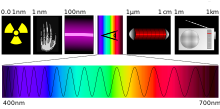Protection against optical radiation
The protection of optical radiation includes measures to prevent coherent radiation ( laser beams ) and other types of artificial optical radiation, such as ultraviolet, visible and infrared radiation.
In Germany, workers are protected from optical radiation and the like. a. regulated by the Occupational Safety and Health Ordinance on Artificial Optical Radiation of July 19, 2010 .
The optical radiation includes
- Infrared (IR)
- Visible light (VIS)
- Ultraviolet (UV)
and belongs to the field of non-ionizing radiation . Optical radiation is part of the electromagnetic spectrum . The radiation can have both positive and negative effects. Depending on the different mechanisms of action, different limit values, laws and guidelines apply.
Legal basis
Europe
In the EU , on April 5, 2006, DIRECTIVE 2006/25 / EC OF THE EUROPEAN PARLIAMENT AND OF THE COUNCIL of April 5, 2006 on minimum requirements for the protection of the health and safety of workers from the risk of physical agents (artificial optical radiation) (19 Individual directive within the meaning of Article 16 Paragraph 1 of Directive 89/391 / EEC) (EU Directive Optical Radiation for short) published.
The guideline comes into force on April 27, 2006 and had to be transposed into national law by April 27, 2010.
- 19. EU Directive DE (PDF)
- 19. EU Directive EN (PDF)
The directive only deals with artificial optical radiation. Natural sources of radiation, such as the sun, are not covered by this directive.
Employer's Obligations
The employer evaluates, measures and / or calculates the exposure to which the employee is likely to be exposed. Building on this, measures must be taken to limit exposure so that the limit values are observed.
Evaluated / measured / calculated
- at LASER: according to the IEC standards
- in the case of incoherent radiation: according to recommendations of the CIE and CEN
- in exposure situations that are not covered by the two above points, national or international scientifically supported guidelines can be used.
The assessment, measurement and / or calculation must be carried out at appropriate time intervals by qualified services or persons. The data must be stored in a suitable form so that it can be viewed at a later date.
The following must be taken into account in the risk assessment:
- Extent, wavelength range and duration of exposure
- The exposure limit values
- Effects on the health and safety of workers in risk groups
- Effects that can result from the interaction between optical radiation and photosensitizing chemical substances
- Indirect effects such as glare, explosion and fire
- Availability of replacement equipment
- Relevant information
- Exposure from multiple sources
- Classification of lasers according to the IEC standard and other artificial radiation sources that can cause damage similar to laser class 3B or 4
- Information on the manufacture of sources of optical radiation
The employer must document the risk assessment and keep it regularly updated.
Germany
A joint regulation for electromagnetic fields and optical radiation is planned
Austria
The VOPST (Ordinance on Optical Radiation) regulates the protection of employees from optical radiation in Austria .
See also
literature
- E Sutter: Protection against optical radiation: laser radiation, incoherent radiation, solar radiation, series of standards DIN EN 60825 (VDE 0837). 3rd edition 2008. ISBN 978-3-8007-3072-8
